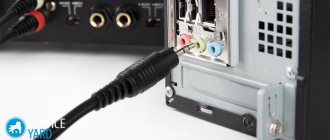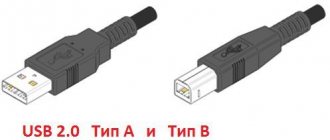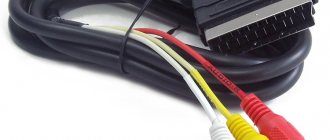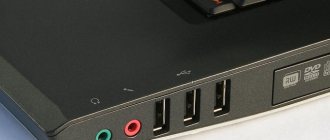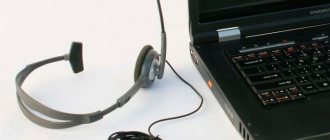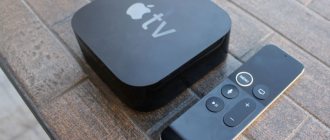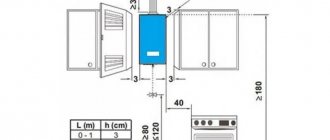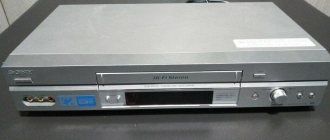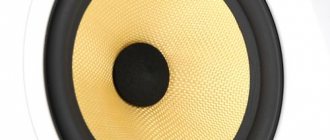To watch a movie with sound or listen to your favorite music on your computer, you need to connect speakers or headphones to it. Let's figure out how to connect speakers to your computer. The connection method depends on the type of sound-producing devices - wired or wireless.
With wire
Wired speakers can be either very inexpensive or advanced music centers. Wires may get in the way on the desk, but such devices reproduce sound without any problems even on old PCs.
How to connect speakers to a home computer or laptop:
- Place the speakers on the table. For harmonious sound reproduction, place the right and left parts correctly - they are usually marked by the manufacturer with the letters R and L, respectively. If there are no markings on the right hand, place the speaker from which the power cable comes.
- Plug the power cable into a power outlet; if you have miniature USB speakers, connect them via a USB cable.
- To directly connect the speakers to your computer, start on the right side. Insert the cable tulips into the speaker connectors, matching the colors of the sockets - place white in the port with a white outline, red - with a red outline.
- Insert the third end of the wire into the computer audio jack located on the back or front panel. The corresponding slot is highlighted in green.
- Connect the right speaker to the left using a wire in two tulips.
- All that remains is to turn on the music to check the functionality of the devices.
Along with the speakers, you can also use a microphone, transmitting an audio signal from it. How to connect a microphone to a computer and at the same time output sound to speakers - insert the cord from the microphone into the correct jack on the computer. It is highlighted in pink and marked with an image of a microphone or the signature mic.
How does the device connection process work?
First, you should turn off your computer so that the connection occurs the first time and so that you don’t have to start over.
Then you should connect the speakers to a power source. This can be either a socket, an internal charging system or a USB cord. However, it is worth noting that speakers with built-in batteries take a long time to charge, which prevents them from being used.
Then you should find a 3.5 mm jack. It is connected to the speaker cable. This connector will be used to connect to a computer.
It looks like this:
Now you need to find a port to connect to the equipment. This is a regular round connector. It is green in color in most cases. Headphones may be drawn next to it or the word “ Audio output ” may be written. It is located next to the microphone or analog input hole.
Now you need to connect the plug from the speakers to the connector on the computer. It is necessary to insert the plug completely; if this is not done, the sound will be unclear or one of the speakers will not work.
You shouldn't use a lot of force to insert the connector. This can damage the motherboard to which the connector is attached.
Improved speakers have an additional option called a " subwoofer ".
It is the second speaker, which is responsible for low sounds. When connected to your equipment, it may not work as the sound card may not support multiple speakers.
Connecting systems with multiple speakers is a little more complicated. For them you need to connect the signal cable to the subwoofer. Typically, such a cable has three different-colored plugs, each of which is connected to its own connector, which is identified by the same color.
Now you need to turn on the computer and adjust the sound as convenient for you. To do this, play any sound, it can be a song or a system sound. If you heard it from the speakers, then everything went well. If not, then turn the toggle switches on the speakers themselves. Sometimes, when purchased, they are sold with toggle switches located in the off positions.
Also, some computers notify the user at the time of connection that a new device is connected to it.
Problem solving
If there is no sound on the PC after connecting, this means one of the following problems:
- The sound is turned off in the settings - click on the speaker icon in the tray and look at the volume level. If set to 0 or muted, simply increase the volume.
- If the speakers themselves have a physical mute button, press it to activate the device.
- Check that the wires are connected correctly by checking the colors on the sockets and plugs.
- In Device Manager, check the drivers for your sound card, and if there are problems, reinstall them.
How to connect speakers to a computer via S/PDIF
Also, the SPDIF digital output can be used to connect 5.1 or 7.1 speakers. In this case, you will need an SPDIF cable (optical or coaxial).
Coaxial SPDIF inputs and outputs look like regular tulip or RCA connectors. In this case, the digital signal is transmitted over a regular coaxial cable with the appropriate connectors. In coaxial SPDIF, information is transmitted in the form of electrical pulses, which can be subject to all kinds of interference and interference. the receiving device usually filters such interference, but the possibility of losing some information is still present.
Optical SPDIF uses an optical cable to transmit information. For its inputs and outputs, Toslink type connectors are used, which are covered with plugs, by which this type of interface is very easily recognized. Optical cable transmission is immune to electromagnetic interference because the information is transmitted in the form of light pulses. Thanks to this, the optical transmission interface is much better protected from external influences than the coaxial one, and provides maximum sound quality.
How you connect your speakers (coaxial or optical) will depend on what type of SPDIF interface your sound card has. The connection process itself is extremely simple, you just plug the cable into the digital output of your sound card and connect it to the digital input on the speaker system. After this, you will need to go to the sound card driver settings and change the signal output port from analog to digital. Although, it is possible that the driver itself will detect the connection to the digital output and switch to the desired operating mode. As for connecting the remaining speakers, everything is exactly the same as when using a conventional analog connection.
Speaker for computer from speaker. No cost
Music Center
If you have a music center at home, you can easily output sound from your computer to it without spending money on buying additional speakers. How to connect the music center to your computer:
- you will need a special wire, at one end of which there is a 3.5 minijack connector, at the other - a white and red tulip;
- insert tulips into the sockets of the music center of the corresponding color;
- place the other end into the PC audio output, marked in green;
- turn on the center, select AUX mode - playback from an external source.
You can output sound to a 5.1 speaker system in the same way, observing the colors of the plugs. But the computer must have a discrete sound card installed, with an increased number of connectors. In addition to the usual outputs for a microphone and front speakers, it has inputs for additional speakers and a subwoofer, and digital S/PDIF.
How to connect 5.1 or 7.1 speakers
If you need to connect speakers that are a 5.1 or 7.1 speaker system, then first of all you need to study the audio outputs that your sound card is equipped with. As a rule, the built-in sound cards of modern computers allow you to connect 5.1 and 7.1 speakers without any problems. To do this, there are 6 connectors on the back of the computer:
- Green output - front (front) speakers.
- Orange output - center speaker and subwoofer.
- Black output - rear (rear) speakers.
- Gray output - surround speakers (side).
- Blue - line input (used to connect an electro-acoustic guitar, player or other equipment).
- Pink—microphone connection.
If your computer has these 6 connectors, then everything is fine, you can connect 5.1 or 7.1 speakers, if there are only three connectors (pink, green and blue), then you will have to purchase a discrete sound card.
If you need to connect 5.1 speakers, then several jacks will be used (green, black and orange). Connect the cable with the green plug to the green connector of your sound card, and then connect it to the subwoofer of your speaker system (to the connector that is responsible for the front (front) speakers). Do the same with all other cables, connect them to the appropriate connectors, be guided by the colors and purpose of the connectors (description above).
Once the subwoofer is connected, you need to connect the remaining speakers to it. Typically, a tulip-tulip cable (or RCA-RCA) is used for this; one end of this cable is connected to the subwoofer, and the other end to a suitable speaker. In this case, you need to ensure that the connectors on the subwoofer are labeled so that all speakers are connected to the correct connectors, otherwise the channels will be mixed up.
After everything is connected, you need to configure the sound card. To do this, go to the driver settings and select the appropriate mode (in this case 5.1).
If you need to connect 7.1 speakers, then you will also have to use the gray connector, which is responsible for connecting the side speakers.
If you have problems connecting, check the instructions for your speaker system or your sound card.
Wireless
Wireless speakers are connected via Bluetooth. On laptops, the Bluetooth interface is usually built in by the manufacturer, but for a computer you will most likely need an adapter - a small device in the form of a flash drive that is inserted into a USB port. Here's how to connect Bluetooth speakers to your computer:
- activate the speakers;
- Press and hold the network connection button on the speaker;
- on a laptop, to turn on bluetooth, press the key combination Fn+F4 or Fn with another function button marked with a wireless connection icon;
- in Windows 10, click on the networks icon in the tray and turn on Bluetooth in the menu;
- In Windows 7, find and activate the connected speaker in the Devices and Printers section of the Start menu.
Also, in any version of Windows, you can launch “Device Manager” and click on the Bluetooth section. In the module properties, select "Enable". A wireless connection icon will appear in the tray, click on it and go to the “Add device” mode. The computer will find the audio source and offer to connect to the equipment.
Possible problems and their solutions
Let's look at the main problems that arise when connecting speakers or headphones:
- no sound;
- the computer or laptop does not “see” the equipment;
- extraneous noise or background.
For every problem there are several solutions depending on the cause.
No sound
If the acoustic equipment is connected correctly, in accordance with our recommendations, then the reason that there is no sound may be:
- The sound is turned off in the system settings. To increase the volume, left-click on the speaker icon and adjust it using the slider.
- Some device models are equipped with buttons or wheels to adjust the sound. Check if it is set to minimum.
Photo: remonton.kiev.ua
- In the sound control panel, which is located in the system sound settings, select the desired device.
PC does not detect headphones or speakers
If acoustic equipment is not displayed in the list of connected devices, it is recommended to check the following:
- Update sound card drivers through Device Manager. We wrote about this above.
- For wireless headphones/speakers, check the condition of the batteries. If they sit down, the PC will not be able to synchronize with the devices.
- There was a malfunction in the system, which includes a set of software, drivers and utilities that ensure stable operation of the equipment. If this happens, then it will be enough to restart the computer.
- The equipment is not within Bluetooth range. As a rule, the signal spreads within a radius of 10 meters without obstacles.
- Incorrect wire connection. Above we looked in detail at which plugs to insert where.
Separately, physical defects should be noted. If the connection is made via USB, then try switching it to another port. Try changing the plugs to the built-in sound card from a discrete one. You should check for mechanical damage on the wires and plugs, as well as adapters, if used.
Sound settings
After successfully connecting the acoustics, all you have to do is configure the sound parameters. How to set up speakers on a computer in Windows OS: right-click on the volume icon in the tray and go to “Sounds”. On the “Playback” tab, check that the correct device for transmitting audio is selected - your speakers. To ensure that music is always sent to the speakers, click on “Default” at the bottom.
In the same window, additional tools are available that will help in case of problems. Right-click on your speakers, select "Test" from the submenu to test the devices. You can also turn off the equipment from here.
Connecting speakers using:
There are several options for connecting speakers to your computer. The most difficult option is using minijack connectors. Here it is important to remember which socket to connect the speakers to on the computer, otherwise they will not work or will begin to be used incorrectly. There are usually 6 connectors installed on the back panel of the system unit, each of them has its own color.
Where to connect the speakers to the system unit:
- a microphone is connected to the pink port;
- green and blue connectors are used by the front pair of speakers;
- The black audio port is used to output sound from the side speakers;
- yellow - center channel, a subwoofer is usually connected to it;
- The gray input is needed for the rear speakers.
Photo of where to connect the speakers to the computer.
These are the most standard sound card settings that are used in most computers. However, colors and their purposes may differ in rare cases.
There are other connection methods: via USB and HDMI, but we’ll talk about them separately.
Portable speakers are increasingly using a USB cable for connection. Their installation is very simple - just select any USB connector, but it is better to use USB 2.0 so as not to occupy high-speed ports that are not needed anyway. Since connecting speakers to a computer via USB is very simple, we will not dwell on the issue in detail. The only difficulty is choosing the correct side of the cable. The port is asymmetrical, so if the plug does not fit, turn the cord 180°.
Few speaker systems connect via HDMI. This standard allows you to transmit a digital signal, that is, video and sound. It is mainly used by high-end devices, such as premium Microlab models. The low popularity is due to the fact that most computers do not have an extra port for connecting HDMI speakers. But all this allows you to reduce the number of wires going to the system unit and allows you to listen to music in high quality.
How to connect speakers to a Windows 10 laptop:
- Find or buy an HDMI cable.
- We connect one side of it to the computer. On laptops, the port is located on the side, and on desktop PCs - on the back cover.
- We insert the other side into the speaker system.
Since it’s not possible to connect old speakers to a computer this way, we can use an adapter. Their significant drawback is that the output sound quality decreases, although non-professionals will not always be able to notice the distortion.
